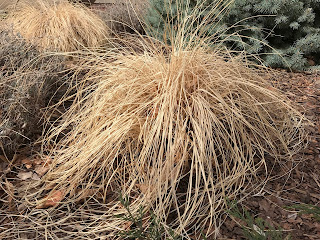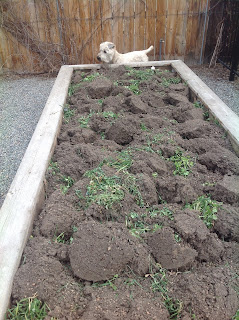Really good news dear reader - the wonderful and helpful garden pull out section GROW from The Denver Post will resume this Friday, March 29 and run through June. Yours truly will be part of the weekly GROW and I will link them here on the blog each week. This week and next week I'll finish the primer on garden terminology. Click HERE for Part I that ran a couple of weeks ago in the Saturday Life & Culture section. In the meantime, below is a late March Punch List for you to get started on another action packed gardening season in our great state.
Let's hope for sunshine, no hail, no late freezes and the best tomato crop ever!
Garden
Conditioning for You –
- Gardening is not only good for your mind and soul, it’s good for your body too.
- According to the online WebMD on average gardeners burn between 200 to 300 calories per hour outdoors. And if you’re digging or doing heavy raking for an hour you’ll burn 500 or more calories.
- Careful not to start out the season with marathon hours in the garden only to wake up with a sore back, muscles and a sunburn to boot. Warm your body first, stretch, then work for short segments with a breaks in between (set a timer). Stretch again at the end of your garden time.
- The first few times out in the garden work for an hour to ninety minutes and stop for the day, especially if you’re not in ski condition or fit enough to enter the next weekend 10K run.
- For a warm-up – walk around your yard or up and down the block for five to ten minutes. This increases blood flow to your body so stretching is much easier on your muscles and joints. When stretching breathe normally, do not move quickly or jerk, just feel slight resistance and no pain.
- After this short warmup do some simple stretches starting with the large muscle groups first. Extend your arms straight up and reach and hold for ten seconds. Then move your arms out to each side and move them up and down like a jumping jack, but no need to jump. Rotate your wrists while moving your arms.
- Next bend forward at the waist and let your arms hang down toward your toes, as you straighten up roll your shoulders back and around a couple of times.
- Sit on a chair and stand up using just your legs for support, this will strengthen your thigh muscles and help with balance too.
- Remember these rules when outside – try not to hunch when squatting or kneeling, keep your back straight. Move as you weed, don’t reach.
- When lifting, bend from your knees, never from your back or waist. Let your stronger thigh muscles do the work. Move closer to the object you’re moving and keep your eyes on it. Maintain a wide stance for more stability and strength. Never twist and lift at the same time. So when shoveling soil… dig, lift the shovel and then move your feet and shovel at the same time to dump the soil in another spot.
- Use a knee pad or kneeler devices with handles when kneeling or placing pressure on your knees. Tractor type scooters can be knee and back savers.
- Many ergonomic garden tools have become available, look for ones with comfortable handles and change your hand often.
- Stay hydrated by carrying a water bottle in the garden or enjoying a glass during each hourly break. Wear sunscreen and a wide brimmed hat.
- Get a tetanus shot every ten years.
General
Landscape –
- Consider doing a soil test now (or if it’s been several years since your last one) to analyze what’s going on in your soil. Without knowing your soil could have too much or be lacking in nutrients or need some help with the structure. A soil test measures pH, texture estimate, fertility levels, amount of organic matter and salt levels. The recommendations from the soil test will help you garden wisely this year. Instructions for taking samples, and pricing - http://www.soiltestinglab.colostate.edu/
- “Hardening off” is an often used phrase as the outdoor gardening season begins. It’s good advice and means that any plant (vegetable, fruit, ornamental) that has been growing indoors at a garden center, green house or in a house needs to be acclimated to being outdoors before being planted in the ground or a container. Set your plant out in the shade for a few hours each day, then to a sunny area for additional hours each day. Do this for five to seven days. If it’s a shade plant, no need to put it in full sun. Keep this in mind as you purchase early pansies and broccoli, then later with warm-season geraniums and tomatoes.
- Clean up the garden by cutting back spent foliage on perennials. Cut down to where new growth is just beginning. Dig and toss last year’s annuals, vegetables or container plantings. Toss in the compost if they were disease-free.
- Rake remaining leaves and any unsightly debris, but use care not to damage new growth on plants or bulbs. Pull or dig weeds as you go.
- If you’re not a DIY schedule sprinkler turn on for late April and core lawn aeration for anytime in April or May.
- No need to fertilize the lawn just yet if a fall (September-November) fertilization from the previous year was done and green up is to your liking. If the lawn is looking good in March and April, wait until May or June for the first spring fertilization. Read more here.
- Use pre-emergent products if grassy weeds have been a problem. The application window is now until the first signs of forsythia blooms. Remember to read all package instructions for application rates and cautions. Many products need to be watered in, so apply right before rain or snow is predicted.
- Wait until late April or early May to prune back roses, even if you see many green canes. Pruning them too early generates growth which can get nipped by cold temperatures and set them back starting a growing season.
- Clean and sharpen garden tools, check local independent garden centers if you're not a DIY, many offer this service, as do hardware stores and lawnmower service centers.
Planting
Beds - Vegetables
- Get a jump on your planting season by warming up your beds with 4 to 6-mil clear or black plastic. It’s sold in roll from garden centers or hardware stores. Anchor the plastic with boards, brick or soil. Leave it in place for a couple of weeks.
- When soil temperatures are 40 degrees or warmer it’s safe to plant hardy cool-season transplants including broccoli, cabbage, or direct seeded kohlrabi, peas, lettuce, onions, radish, spinach, turnips and potatoes (planted below in #15 Smart Pots).














